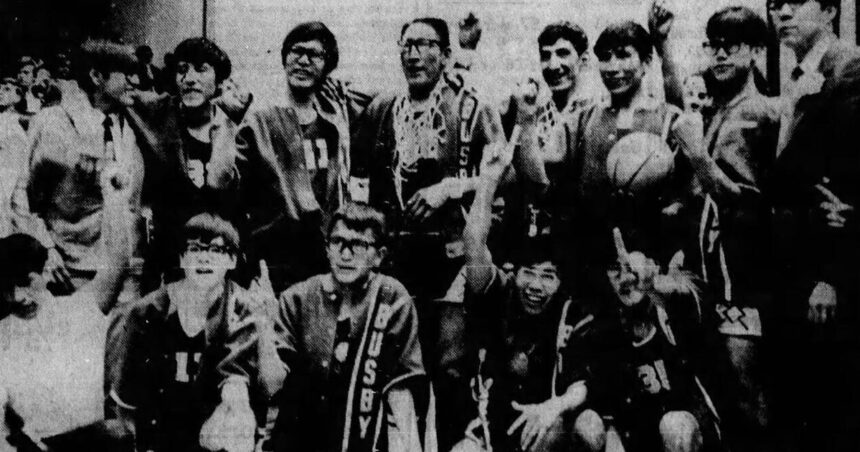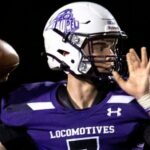“And if those Indians were grinning, you were in trouble,” – Sqeez Sullivan, Hingham assistant coach
BILLINGS — When Oliver Flying entered the Busby boarding school at age 5, he was not allowed to speak Cheyenne. He recalled how difficult it was to string an English sentence together.
Years later, at the 1971 Southern C divisional basketball tournament, Busby’s 6-foot-3 point guard, Melbert “Moke” Eaglefeathers, received a pass at the top of the key from Tommy Crazy Mule. Grinning, Moke shouted in the Cheyenne language while looking directly at the great Flying.
But as Eaglefeathers’ eyes were squarely on Flying, he rifled a pass in the opposite direction to Elwood His Bad Horse Evans.
People are also reading…
Evans scored easily and then, talking in Cheyenne, gave instructions on a new full-court defense. A beaming Eaglefeathers was still staring at Flying. The crowd roared. They thundered when Flying swiped the inbounds pass and whipped it to a sprinting Eaglefeathers for another effortless score. The Busby BIA Boarding School Eagles had just scored four points in two seconds.
Suddenly, three Eagles once again triangled their bewildered opponent in a trap. Their proud Cheyenne ancestors from the-long-ago-days chuckled.
Both referees blew the whistle. Five-second infraction.
Indeed, it was another coordinated sabotage of ball snatching.
The Busby Eagles came with a swagger, ordained by their community. The federal boarding school team played like liberated bear cubs, escaping their mother’s watch. When they performed well, they grinned. When they grinned, they shoe-shined opponents.
When Coach Allan Young Bear (later Anglicized to Young) snapped the tentacles off their half-court defense, they ranged and trapped, a feeding frenzy of ball swiping.
Or, when their opponents were cornered, they panicked and threw passes away – sometimes smacking inattentive fans.
When Busby pressed, they didn’t play like five independent, unmanned firehoses.
Instead, the Eagles, or as the media called them, “the Indians,” played with coordinated flair. They operated their vaunted defense based on John Wooden’s UCLA philosophies. They talked in Cheyenne to fool their opponents.
“And if those Indians were grinning, you were in trouble,” recalled Hingham assistant coach Sqeez Sullivan.
Warbonnets and the Morning Star
One week later, March 20, 1971, the Carroll College Physical Education Center in Helena was swollen. It was a few minutes before 9 p.m. and another Class C title game in the capital city.
The Saco Panthers and Busby Eagles were warming up. It was a sellout, with hundreds turned away. Denied entry, many went to their cars in the parking lot and turned on their radios.
The undefeated Panthers were looking sharp in their all-black pajama warm-ups. The Black Cats were stuffed with an excess of talent four starters would play in college, the fifth earned an appointment to West Point.
The Busby Eagles wore their warbonnets with dark blue and gold warmup tops. They sported the sacred Cheyenne Morning Star on their trunks. Ten of the 11 claimed Cheyenne heritage. The 11th, Elmer Ogle, was Sioux from the Fort Peck Indian Reservation, a key Cheyenne ally in the Plains Indian Wars.
Every Busby player could claim heritage to that conflict.
“We were all Cheyenne at state,” cheerleader Donna Little Wolf recalled. “All of the cheerleaders and the team.”
The Panthers and Eagles would settle it again with Busby wanting a bite from the revenge apple.
The head-spinning Panthers had won 30 in a row. Their streak included a 78-61 thumping of Busby on the same gym floor the year prior, when the two opponents clashed for the consolation title.
Saco had the only perfect record in all of Class C. Led by 6-7 senior Rocky Tollefson, the Panthers returned a squad that included everything needed to win: size, speed, experience, intelligence, motivation, a deep bench, and the ability to score.
However, there was one Panther hiccup. For the Helena tourney, they were missing some ballhandling reserves a deficiency that emerged in their first games against Phillipsburg and Hingham with Saco escaping with close wins.
Busby’s Young Bear took note of Saco’s new shortcomings. He would launch his hyped full-court press when needed.
And whatever you do, don’t gawk at them
“They were always smiling,” recalled Rosebud coach Garry Pace of the Eagles. Pace’s Wranglers played “the old boarding school” during his Rosebud tenure in the late 1960s. “Man, they could play. I remember Eaglefeathers, always smiling.”
Pace recalled Busby’s warmup drills: “They were fun to watch,” said the former Western Montana College football star.
With flashy moves, sudden quickness, and an upbeat flair, the Cheyenne team entertained fans. Confident and Pollyannaish, the Eagles whizzed artistic passes, took inventive shots. Amusement was the key ingredient to their pre-game ritual. However, their customary warmup didn’t please all fans. A rival superintendent called them, “that hot shot team.”
Pace, who is in the Montana Western Athletic Hall of Fame, was not happy when his team stood and gawked at the Eagles warming up. It was the first time they played, and the Rosebud coach was fuming. Interviewed from his Boulder home many years later, Pace smiled and shared colorful memories.
Of course, losing to the cackling Busby Eagles didn’t help his frustration. Especially if they were snickering jokes in Cheyenne.
Pace made note of his unfocused team. By gosh, the next time they played, it would be different.
For their next Busby game, Pace emphasized in the locker room: “And whatever you do, don’t gawk at them when they warm up!”
The Wranglers agreed. They would focus on the upcoming game. They would concentrate on their own warmup drills. They conducted their team cheer and promptly disappeared into the gymnasium.
Moments later, Pace entered the arena.
His team, standing, watching Busby warming up.
“They pressed and ran and man, they had fun,” remembered Pace.
Busby guard Jacob Tall Bull said it was a UCLA invention: “We trapped the ball in the corner.”
Every Eagle was cut from the same cloth. They were sprinting and jumping whitetails. Every ballplayer could dribble and shoot.
Offensively, “They could all handle the ball,” said Pace. “Good athletes.”
“Every one of them could bring the ball up,” remembered Darrell Longfox, a fan from Fort Belknap.
Nailing a backboard to an outhouse
Busby, Montana, on U.S. Highway 212, Custer’s death road, and just south of Rosebud Creek. The U.S. 7th Cavalry camped here in 1876, the night before crossing over the next divide to the west the Valley of the Little Big Horn.
When Moke was a youngster in Busby, his grandfather nailed a coffee can to the wall so his grandson could shoot rolled up socks into it.
Later it was Busby’s White River Cheyenne Mennonite Church minister, Willis Busenitz, who nailed a backboard and rim to an outhouse on the church grounds for a junior high student named Melbert Eaglefeathers.
“Moke shot baskets for hours,” recalled Busenitz, years later.





